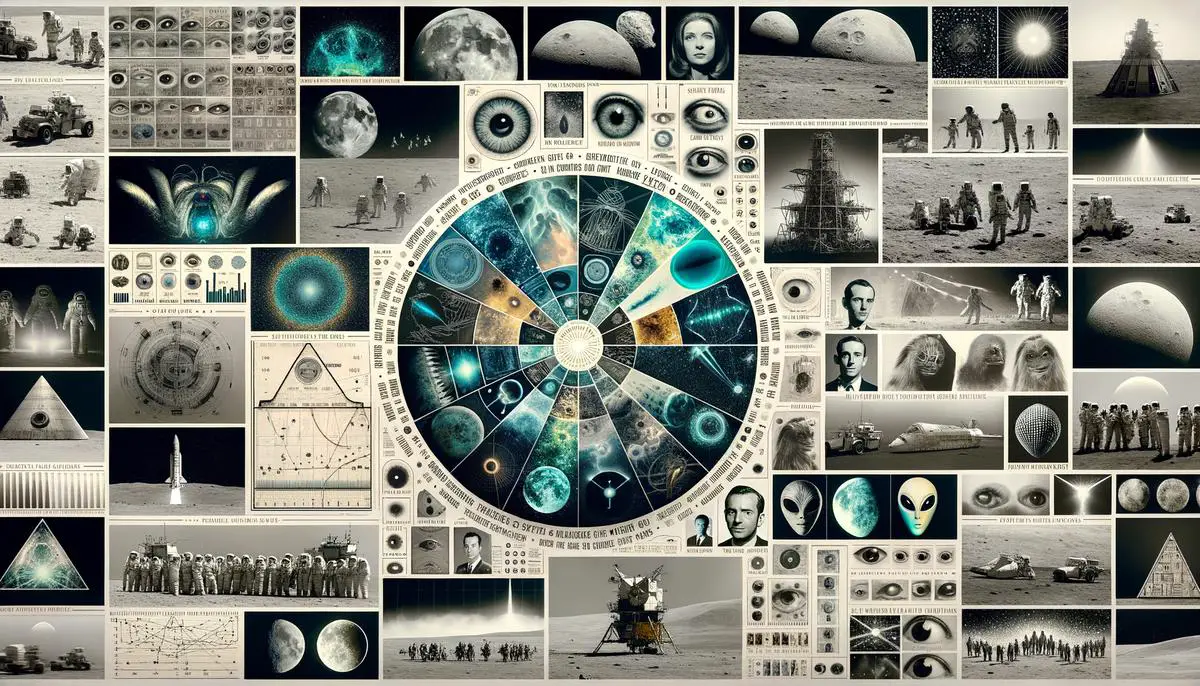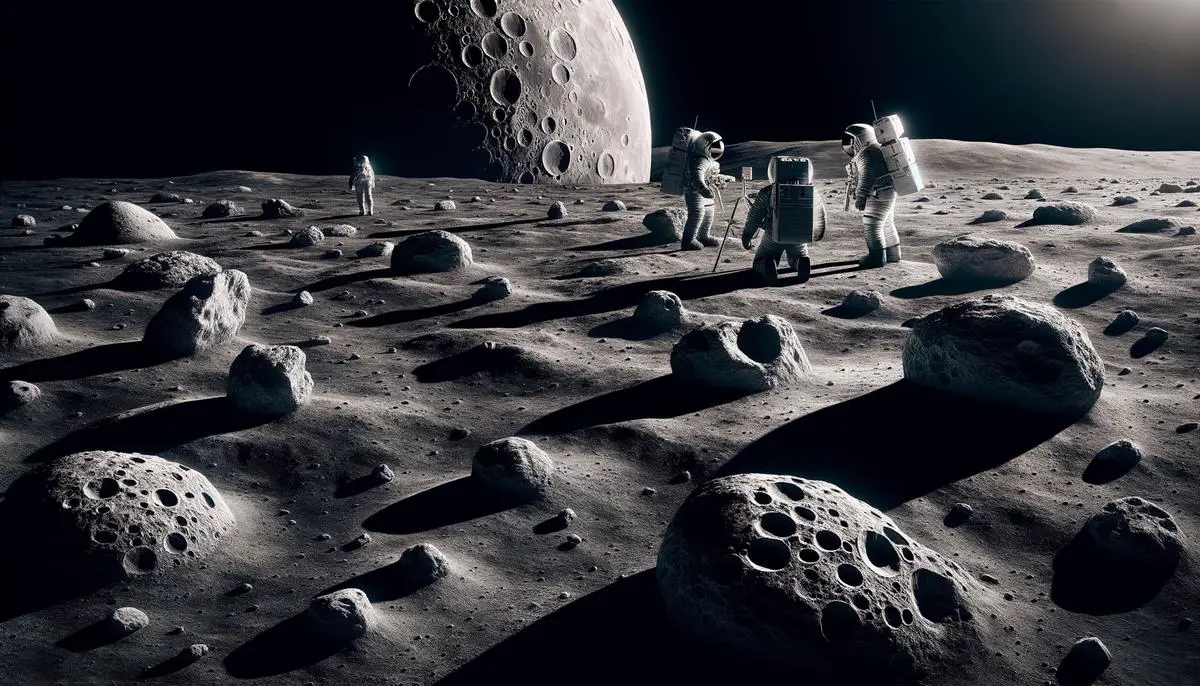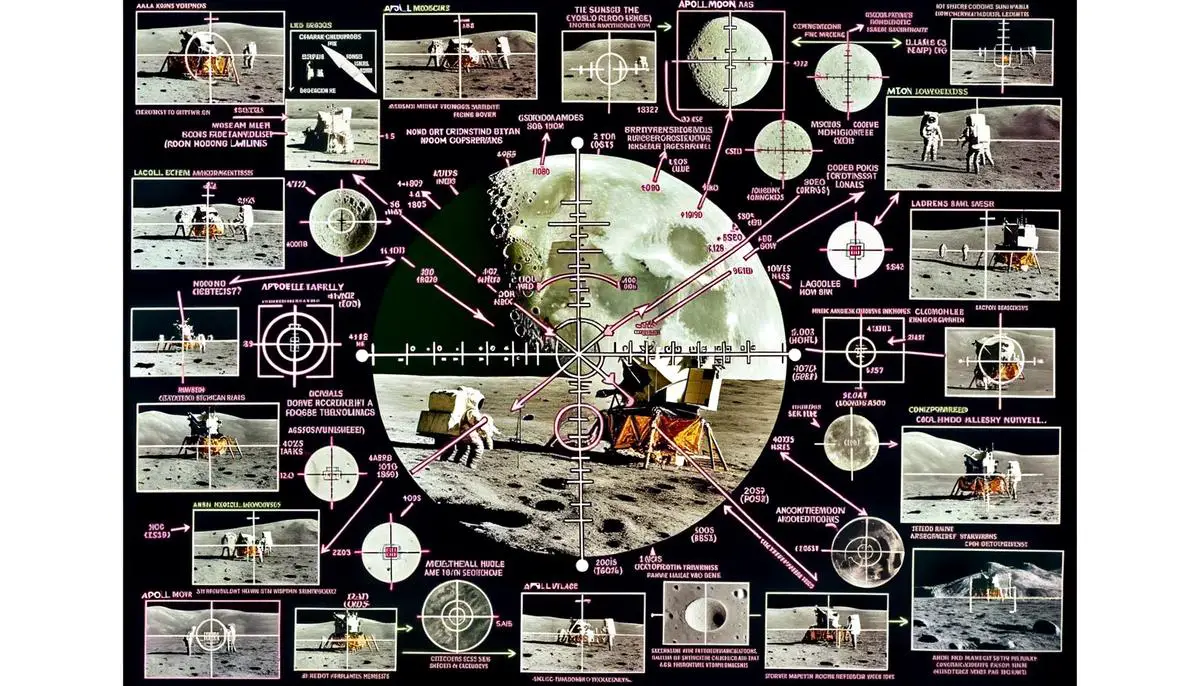The Apollo missions have captured our imagination and curiosity with their breathtaking feats and the stunning images they’ve brought back from the moon. Among these photographs, however, lie peculiar anomalies that have given rise to a myriad of discussions, theories, and debates. Whether these are simple quirks of space photography or evidence of something more intriguing, this article aims to shed light on the mysteries surrounding these anomalies, offering insights into the countless wonders and complexities of lunar exploration.
Contents
Anomalies and Artifacts in Apollo Imagery
Exploring the Secrets Behind Apollo Photo Anomalies
The Apollo missions, a series of space explorations led by NASA that successfully landed humans on the Moon, have provided us with some of the most iconic images in history. However, nestled among these photographs are anomalies that have sparked debates, theories, and outright conspiracies. Today, we’re diving deep into the mysteries of these Apollo photo anomalies – let’s get started!
- The Unexplained Objects
- The Anomalous Shadows
- The “C” Rock
- The Waving Flag
- Crosshairs Anomalies
Some Apollo photos showcase objects that, at first glance, seem out of place or unusual. This includes mysterious shadows, odd shapes, and unidentifiable figures in the distance. Space enthusiasts and skeptics alike have poured over these images, questioning whether they might be evidence of extraterrestrial life or previously unknown natural lunar phenomena.
Several images from the Apollo missions show shadows that appear to contradict the expected light source, the Sun. Critics argue this suggests multiple light sources were present, implying the photos were taken on Earth with artificial lighting. Proponents of the missions, however, explain these discrepancies through lunar topography and the unique way light behaves in the Moon’s atmosphere-less environment.
One peculiar photo from the Apollo 16 mission shows a rock with what seems to be a perfect “C” engraved on its surface. Some claim it’s proof of props being used, hinting at staged lunar landings. Experts and NASA, though, have clarified that the “C” is likely a hair or fiber that found its way into the development process of the photograph, debunking the prop theory.
Photographs and footage of the American flag waving on the Moon have fueled speculation, considering there’s no air on the lunar surface to cause the flag to flutter. NASA explains this occurrence with the flag’s design: a horizontal rod was inserted to display the flag fully. When astronauts planted it, they twisted it back and forth, creating the appearance of it waving.
Some images contain crosshairs that appear to be behind objects, rather than overlaying them, as would be expected since these markings were etched onto the camera’s lenses. Conspiracy theorists suggest this as evidence of tampering or layering in the photos. Logical explanations, however, point to overexposure: the bright white of the object or reflection can cause the thin black crosshairs to disappear against the white background, a common occurrence in photography.
While the mysteries of these Apollo photo anomalies have been met with a mix of skepticism and fascination, most have been addressed with scientific explanations or rational clarifications. From the peculiarities of lunar physics to the quirks of photography, these anomalies serve as reminders of the complexity and intrigue of space exploration. The Apollo missions not only expanded our understanding of the Moon but also opened a window into the challenges and wonders of documenting the uncharted territory beyond our Earth. Whether these anomalies are glitches, artifacts, or quirks of lunar exploration, they undeniably add to the rich tapestry of human achievement in space.

The Analysis of Unusual Lunar Surface Features
Now, let’s dive deeper into the rabbit hole of lunar mysteries. There’s more that beckons our curiosity beyond the usual suspects of oddities captured in Apollo missions’ photos. After all, the moon has been a subject of fascination not just for scientists but also for conspiracy theorists and space enthusiasts alike. What makes the lunar surface a canvas for such wild speculations and debates? Let’s explore further.
Lunar Landscape: A Playground of Optical Illusions?
One of the most thrilling aspects of lunar exploration is the terrain itself. The moon’s surface is littered with craters, mountains, valleys, and rilles. These features, under the harsh lighting from the sun, can create dramatic shadows and illusions. Some folks argue that these peculiar shadow patterns are evidence of alien architecture or artifacts. However, scientists explain that the moon’s environment and the sun’s angle can play visual tricks on us, creating patterns that seem unnatural but are purely the product of natural topography and lighting conditions.
The Mysterious TLPs (Transient Lunar Phenomena)
Transient Lunar Phenomena, or TLPs, have been reported by astronomers for centuries. These are temporary changes in brightness or appearance of spots on the lunar surface. Observers have noted flashes of light, color changes, or areas that suddenly appear to move or blur. While some have speculated these may be signs of active lunar life or alien activity, most scientists believe TLPs result from natural occurrences like moonquakes, gas release from lunar faults, or asteroid impacts that stir up dust and gas.
Enigmatic Lunar Mascons
Mascons, short for mass concentrations, are regions on the moon with unusually high gravitational pull, discovered through the tracking of lunar orbiters. These mascons significantly influence the moon’s gravity field, leading to peculiar orbital patterns of spacecraft. The presence of mascons initially baffled scientists, prompting theories of massive alien bases hidden beneath the lunar surface. Through further study, these mascons were understood to result from giant asteroid impacts that created dense craters filled with metal-rich asteroid material, altering the moon’s gravitational field in those areas.
The Debate Over Moonquakes
Moonquakes are yet another natural phenomenon that stirs the pot of lunar mysteries. Unlike earthquakes, moonquakes can last for up to an hour, mainly because the moon doesn’t have water to dampen seismic vibrations. Some speculative minds suggest that these quakes could be the result of alien or man-made activities beneath the moon’s surface. Yet, scientific research points to these quakes being caused by tidal forces from Earth’s gravitational pull or from the cooling and contracting of the moon’s interior, which can fracture its crust.
Wrapping Up the Lunar Enigma
The moon, with its stark beauty and barren landscapes, will undoubtedly continue to inspire wonder and speculation. Its surface, marked by the footprints of Apollo astronauts, remains a testament to human curiosity and our quest to explore the unknown. While unusual features and phenomena can stir the imagination toward extraterrestrial interventions, it’s the natural explanations—grounded in robust scientific inquiry—that illuminate our understanding of our only natural satellite. From optical illusions cast by its rugged terrain to the natural occurrences behind moonquakes and mascons, the moon’s mysteries often have earthly explanations that are no less wondrous.
As we continue to gaze at our lunar neighbor, let’s remember that the line between mystery and knowledge is a journey paved by curiosity, imagination, and relentless pursuit of understanding. The moon, with all its enigmas, remains a beacon for explorers, dreamers, and skeptics alike, challenging us to look beyond the obvious and embrace the wonders of our universe.

Lighting and Shadow Discrepancies
Shifting our focus to a fascinating aspect of the Apollo missions, let’s dive into the peculiar case of lighting and shadow discrepancies observed in the iconic photos from the lunar surface. Many have scratched their heads, wondering how certain images depicted such oddities, considering the Moon’s environment and the technology of the time. Buckle up as we uncover the layers behind these photographic mysteries.
First things first, the Sun is the primary source of light on the Moon. Without an atmosphere to diffuse sunlight, shadows on the Moon are sharper and darker than what we’re accustomed to on Earth. This unique lighting scenario sets the stage for some truly intriguing photographs captured by the Apollo astronauts.
One hot potato in the realm of lunar photography deals with the direction of shadows. In several Apollo photos, shadows cast by rocks, the lunar lander, or the astronauts themselves appear to diverge or point in different directions. At first glance, this might seem like a smoking gun for lighting inconsistencies. However, the explanation is surprisingly straightforward yet fascinating.
The lunar surface is far from a flat, even plane; it’s filled with hills, craters, and undulations. When sunlight hits these uneven surfaces, it creates shadows that can appear to diverge or converge, depending on the terrain’s contour. It’s an optical illusion similar to what artists use to create depth and perspective on a flat canvas. This means that photos showing seemingly mismatched shadows are actually showcasing the Moon’s rugged topography tricking our Earth-adapted perceptions.
Another aspect that fuels the debate revolves around the appearance of ‘hot spots’ or unusually bright areas in photographs, coupled with the visibility of objects in shadowed regions. Critics argue this suggests artificial lighting was used, akin to a film set. However, there’s a natural explanation: lunar regolith, or moon dust. This substance has a peculiar property known as retroreflection. The regolith’s tiny glass spheres can bounce sunlight back directly toward its source, creating bright spots in photos. Moreover, sunlight bouncing off the lunar module and other equipment can illuminate shaded areas more than one might expect in an Earth-like setting.
Lastly, let’s tackle the issue of color in some Apollo photos where certain shadows aren’t pitch black but have hints of color or appear less intense than anticipated. Again, this can be attributed to the scattering of light. Since the Moon does have a thin exosphere, some light scattering does occur, primarily as a result of sunlight reflecting off dust particles suspended above the lunar surface. This scattering can diffuse a bit of light into shadowed areas, slightly lifting the shadows and sometimes imparting a subtle coloration due to the mineral composition of the lunar soil.
So, there you have it. The peculiarities observed in the Apollo mission photos concerning lighting and shadows aren’t the product of fabrication or studio trickery but rather the fascinating interplay of sunlight, lunar terrain, and the reflective properties of moon dust. These unique conditions craft a visual spectacle that sometimes confounds our Earth-bound expectations but, upon closer inspection, offers a deeper appreciation for the complexities of capturing photographic moments on the Moon.

Crosshair and Photography Technique Analysis
Crosshair inconsistencies in Apollo photos have sparked a flurry of debate and speculation. These intriguing anomalies relate to the small plus-shaped markers found in the photographs taken by the astronauts during the Apollo missions. The purpose of these crosshairs, also known as reticles, was to provide a means of measuring distances and angles in the images, aiding scientists and researchers back on Earth. However, some observations about these crosshairs have raised eyebrows and fueled conversations about the authenticity of the Apollo missions. Let’s dive into what these inconsistencies might reveal.
The Overlapping Dilemma
One of the most talked-about issues is instances where crosshairs appear to be behind objects in the photos, rather than on top of them as expected. Normally, these markers should overlay everything in the photograph, given they are etched onto the camera’s lens. However, in some images, parts of the crosshairs seem to vanish behind equipment or the lunar surface. Skeptics argue this suggests manipulation or alteration of the original photos. Could this imply a grand hoax, or is there a simpler explanation, such as photographic overexposure causing the reticles to appear faded or invisible against bright objects?
The Shift in Perspective
Another intriguing observation is the apparent shifting or rotating of crosshairs in some photographs. Given the fixed position of the reticles on the camera’s lens, one would expect their orientation to remain constant across all images. Yet, there are instances where the crosshairs seem to rotate slightly or shift in position relative to the photo’s frame. This phenomenon has led to theories about the photos being staged or doctored. However, could the explanation lie in the camera’s handling, or perhaps the effects of copying and digitizing the original film photographs?
The Disappearing Acts
Additionally, certain photos show crosshairs that are partially or completely missing, raising suspicions about the editing of images. Critics point to this as evidence of tampering, where objects were supposedly added or removed. On the flip side, photography experts highlight that overexposure or the photographic process itself, especially in high-contrast situations, might cause the reticles to blend into the background, seemingly disappearing.
The Curious Case of Quality
The quality and clarity of the crosshairs also vary across different Apollo images. Some photos show crisp, clear reticles, while others display blurry or distorted markers. This variance has fueled speculation about the cameras and film’s consistency and quality used during the missions. Yet, could the differences be attributed to the harsh lunar environment, including extreme temperature fluctuations affecting the camera’s operation and film quality?
Bridging the Gap
As we explore the peculiarities of crosshair inconsistencies in Apollo photos, it becomes clear that there’s a fascinating interplay between photographic technology and the unique lunar environment. While conspiracy theories offer tantalizing tales, the explanations often lie in the realm of photography’s technical aspects and the challenges of shooting in space. Understanding the context in which these photographs were taken, including the limitations of 1960s and 1970s technology, is crucial in bridging the gap between anomaly and explanation.
In conclusion, the crosshair inconsistencies in Apollo photos serve as a compelling topic for discussion, blending science, technology, and a dose of mystery. While skeptics may point to these anomalies as evidence of foul play, a deeper dive into photography’s nuances and the conditions of space exploration often reveals more grounded explanations. Nonetheless, these discussions contribute to a greater appreciation of the monumental achievement of lunar exploration, reminding us of the Apollo missions’ lasting impact on science, technology, and culture.

As we unravel the mysteries behind the anomalies found in Apollo mission photos, our understanding of these peculiarities not only expands our knowledge of space exploration but also highlights the ingenuity and resolve of those who ventured beyond our earthly confines. The Apollo missions, with all their scientific achievements and the debates they inspire, continue to fascinate and inspire us, showing that despite the technological limitations of the past, human curiosity and the pursuit of knowledge know no bounds. The discussions surrounding these photo anomalies enrich our appreciation for the landmark endeavor that was the Apollo missions, bridging the past’s achievements with the future’s potential.
